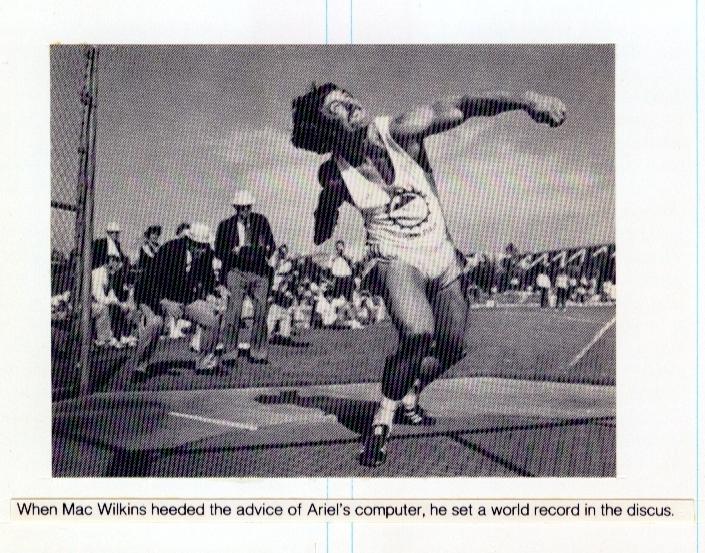| Previous | Index | Next |
![]()
point of foot placement. "You see pictures of runners, it looks like they're landing on their heels, but they're not. The good ones don't. They flick the foot down flat at the last instant. All these companies are making wonderful heels and the best runners are never coming down on them." One company, Pony, bowed to Ariel's advice and has brought out a shoe tested in his lab.
Visiting Ariel's office and laboratory, tucked away in a storefront between Erik's Giant Subs and Radio Shack, one sees wonders everywhere, like the electronic display on which he can call up the style of a shotputter or quarterback in the form of a sequence 'of glowing green stick figures. "You have to be very responsible to change the form of any good athlete," he says. "The better the athlete, the more it seems wrong to fool with him." So Ariel has programmed
the computer to fool with an electronic copy of the athlete instead, changing angles, timing, even weight, and with each change he computes how performance would be affected. Seeing that, the imagination goes spinning off into a giddy future, where performance can be predicted years in advance, where technique and training can be fitted to individual talents. It turns out that Ariel is already disappearing into that future.
"We examined film of Dick Fosbury winning the Olympic high jump in 1968 and of Valery Brumel jumping his ear
tier world record of 7' 53/,". We found that of the total forces generated, the flop style has a higher vertical component. The computer had Brumel use the flop. Had he known about it when he was jumping, Brumel could have cleared 7' 11 ". So we will one day see an eight-foot high jump."
Bud Greenspan, who produced The Olympian series on PBS television, provided Ariel with slow-motion film from 1936. He wanted to know who was the better sprinter, Jesse Owens or Eddie Hart, the present coholder of the world record for 100 meters at 9.9 seconds. Owens had run 10.2 on cinders, without starting blocks, Hart on polyurethane, with blocks, but Ariel saw no problem. "We knew the angular displacements, so we knew how many degrees per second their ankle, hip and knee joints displaced. We knew the
length of the bones and the speed of the film frames, so we knew how much distance was covered per second. We let each man cover 100 meters and computed the time it took him." The winner? Jesse Owens.
The precision with which Ariel's machines can trace movement patterns has widespread application in injury prevention and treatment. "Any little pain will change the pattern of locomotion," he says. Just now. Ariel has finished an analysis of film sent by the Dallas Cowboys, who wanted to find out if injured players
were returning to normal patterns.
The possibilities for rehabilitation, or the teaching of any sort of muscular coordination, are enormous, especially now that Ariel has a little computer that can take instructions from a stick. Unlike the $8 million University of Massachusetts computer that Ariel dealt with through telephone connections and a Telex keyboard, his new one, the size of an electric stove and costing only $60,000, displays a set of functions on a screen and the operator selects the one he wants performed by directing a floating indicator light with a lever Ariel calls a joy stick. In a slot goes a black, magnetic insert that can hold nearly a million bits of information. The term for these is flexible diskettes-"floppy disks," in Ariel's argot. "In scientific training, a man will have his own floppy, containing his whole athletic history and an individual, program computed for his needs. As he, works in the gym or on the field, the computer will monitor him, giving him instant feedback directions ... congratulations." Dr. Gerry Purdy, author of
Computerized Running Training Pro
grams and one of the few men in the field who share Ariel's dual expertise in computers and exercise science, says of this, "My first reaction is that he's bordering on artificial intelligence. Academically, it's not unreasonable, but from a practical standpoint, it's like Star Wars."
Yet clearly the last obstacle to such an instant system is the fact that film takes time to be developed, and video tape is not yet a suitable replacement because of insufficient clarity and speed. But we are at a stage now where a computer can divine an athlete's optimum technique in an event and coach him toward it. "Of course, if a high jumper doesn't want to land on his back, that's another problem," says Ariel. "That's psychology. We can't do anything about that."
Gideon Ariel's own psychology is nearly as fascinating as his science. A clumsy, shy boy, he grew up in a boarding school near Natanya, about 20 miles north of Tel Aviv. Poor in sports, he nonetheless longed to be an athlete, and in 1956, when he was 17, he found that the best Israeli discus man had thrown less than 160 feet. Something clicked. "I can do better than that," he said and embarked upon four years of training, almost demented in his intensity. Speaking to a class at Amherst, he said, "If
SPORTS ILLUSTRATED August 1977

![]()
| Previous | Index | Next |